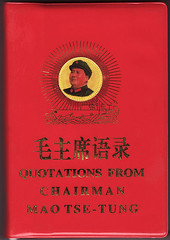
Carrying the welfare of the peasantry on your shoulders? Concerned that your next five-year plan is going to be your last?
20th century Communist revolutionaries raised content marketing to an art form, and so can you!
You're devoted to your cause. You have a small, agile band of fellow travelers, you're willing to work tirelessly, and you have deep wellsprings of self-belief.
Unfortunately, the supply closet is always empty. You're cash-poor, even living off ramen noodles is a fantasy sometimes. You're trying to meet the public's needs with an idea, so your founding documents are important; unfortunately, some of the most important ones are incomprehensible to all but a tiny minority of the literate population.
Startup or Communist cell? Wherever a small group of people deploy information to tip the behavior of a much larger group, there's a content marketing lesson.
Here are a few lessons from the ultimate believers in the people's power.
1. Institute relentless ideological self-criticism
Chairman Mao remarked:
Dust will accumulate if a room is not cleaned regularly, our faces will get dirty if they are not washed regularly. Our comrades' minds and our Party's work may also collect dust, and also need sweeping and washing…

The next marketing classic?
No one wants to spend months on a project only to find that it's useless to everyone outside their own closed loop, so approach your long-term projects in a spirit of self-critique.
It doesn't all need to be self-criticism either. Subject area experts will often be willing to comment on unreleased content, so try engaging them in conversation on semi-related topics in groups, then breaking out to contact them for tips on subjects that require their specialized knowledge.
If you're working on a more complex website or project and have a little budgetary space, user testing makes great self-criticism, too.
Usability science is basically design Communism. It begins with the honest impulses of the proletariat (the customer or visitor), examining problems they encounter and approaching them as your design challenges, with the frictionless dictatorship of the user's needs as the ultimate goal.
The point isn't to do it occasionally, but to make cyclical, incremental redesign part of your routine. (Sites like usertesting.com yield data from seasoned testers, which isn't a good thing - but something is better than nothing, and the low price may help you secure your commissar's buy-in...).
Think of it as a state of permanent revolution.
2. Find a process that works, and iterate, iterate, iterate
Both Lenin and Mao have been quoted as saying, "Quantity has a quality all its own." If you edit a blog, for example, don't just look for interesting one-off pieces of content. Instead, look for successful processes that you can come back to again and again.
Someone at Warby Parker decided to turn the company's 2011 annual report from an obligatory, tree-killing, snooze-inducing bit of corporate hackery into a gorgeous infographic, and after they won plaudits from marketing blogs, they had themselves a formula.
If they don't do it again every year from here on out, they'll hear the disappointment from coast to coast.
3. In branding your content, it's at least as important to be consistent as it is to be excellent

The flagship Russian vodka isn't called 'Russian Amazing', it's called Russian Standard.
The Bolsheviks were hardly deaf to branding. The name comes from the Russian word for 'majority', thanks to it having dominated a single vote on tactics at a single meeting in 1905.
Ironically, though, the party was far from the majority outside its own meeting halls. The moderate Menshevik ('minority') party had far more popular support in the immediate post-Revolutionary period, but you wouldn't know that from the name. Branding win for the Bolshies!
Beyond the superficial, though, developing content is easy when you have filmmakers like Dziga Vertov and Sergei Eisenstein at your disposal, or artists like Dmitri Moor.
It can't have hurt the branding that early Communists actually paid attention to theoreticians, too, building a consistent look in visual media by using disjunctive editing techniques in cinema, and bold, colorful poster art.
We'd all like to have Spike Jonze direct our product videos or Cormac McCarthy write our press releases, but you don't need them, because you can always make sure your content hits similar visual notes across platforms.
This is one of those efforts that might seem wasted at first, but becomes more important as you go from revolutionary cell to full-fledged party apparatus, so lay the groundwork for branding early.

Medical startup ZocDoc has a look-and-feel that isn't striking by itself. The font is unflashy and the color scheme not particularly eyecatching, but it's consistent across the Twitter account, website, on press releases, in the company fact sheet and app… absolutely everywhere.
Even their company timeline is branded with the friendly, welcoming cartoon doctor. It doesn't take complicated motifs or Apple-like design savvy to spruce up a press release, just a few versions of your logo and careful coordination.
It's vastly easier to make small refinements as you go than it is to retrofit branding to years' worth of content.
4. Don't talk to the people about what interests you, talk to them about what interests them
Regardless of what your KPIs are, if you're in content marketing, you're in the business of getting attention: for a brand, a product, a website. Tailoring your media to the audience might seem obvious, but it can be perilously easy to forget.
Case in point: at MyParkingSign we came up with an idea for a sign that reads 'TAKING MY SPOT? TAKE MY DISABILITY" (inspired by a similarly worded sign common in France).

We hung the sign around Brooklyn, snapped a bunch of photos, and started to get in touch with journalists. Virtually no one bit.
I'd forgotten one important fact: accessible parking isn't as much of a problem in New York as elsewhere; so of course New York-based journos didn't see our work as worth picking up.
Had I tried the same thing in Florida, it might have worked, but I'd been focused on an interesting product and not the audience.

Would Lenin have earned his vegetables by droning on about surplus labor valuation?
As Whittaker Chambers observed in Witness, his memoir of his early life as a Commie, a life lived among party functionaries can make it difficult to see outside the party. We live, eat, breathe our products; we sometimes forget to make sure our work has informational scent to anyone but us.
The simplest, most obvious step: talk to your comrades about the projects you're working on. Not just your colleagues, your friends.
If their eyes glaze over, it might be time to go back to the drawing board. If you feel like you have a content idea you can run with, lay the groundwork by contacting journalists or bloggers with whom you have relationships for tips in the brainstorming phase, rather than merely building the content and pushing people to come to it.
Particularly for those of us who market content in the B2B space, if you can interest someone outside of your target market in content, you're probably well on your way to inbound links and/or traffic.
Producing user-centered content takes practice, keyword research, and a willingness to abandon principle for results, but it's essential.
5. Being an outsider is a competitive advantage
After the 1917 abdication of Tsar Nicholas II, the Bolshevik party opted to remain outside of government, even though the Provisional Government had all the hallmarks of an inclusive democracy.
Instead, the party deployed newspapers and agitators to snipe at the moderate parties in the government. A wise decision, as anyone who disliked the disorganized government's policies found themselves with a ready ally.
Over a month or two, the number of Bolsheviks in St. Petersburg grew from 2,000 to 15,000. Many were in the military, making them valuable recruits indeed.
What does this mean for content marketing practice? Instead of struggling to keep up with competitors' processes that are probably well established, be where your competitors aren't.
- Conduct an informal content audit of your competitors. They've never heard of Vimeo or YouTube? Fire up the cameras. Their sites are stodgy? Think about what you can gamify on your own.
- Do a few of your competitors' inbound links lead to pages that are old or outdated? Quickly build content that improves on what they've done, put it on your own site, and send an email to the linking site's webmaster, suggesting that they direct traffic your way instead.
The Bolsheviks' plans to topple the Tsar were decades in the making, and you'll notice two of these tips involve a little forward planning.
Branding requires up-front design work and a long-term sense of strategy, while good content marketing means a skilled outreach team that should forge relationships with nonprofit partners, bloggers, journalists, and subject area experts well before they're needed.
Fortunately, there are way less interesting things to spend your time on than reading up on and then contacting the leaders in your industry! ????? - Good luck, comrades.
No hay comentarios:
Publicar un comentario